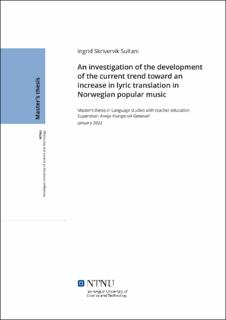| dc.contributor.advisor | Annjo Klungervik Greenall | |
| dc.contributor.author | Sultani, Ingrid Skrivervik | |
| dc.date.accessioned | 2022-07-09T17:20:03Z | |
| dc.date.available | 2022-07-09T17:20:03Z | |
| dc.date.issued | 2022 | |
| dc.identifier | no.ntnu:inspera:109722273:9628836 | |
| dc.identifier.uri | https://hdl.handle.net/11250/3004338 | |
| dc.description.abstract | De siste årene har det vært en tydelig økning i antall oversatte sanger som har blitt fremført på ulike mediaplattformer, som TV, radio og streaming. Denne økningen har vært spesielt tydelig på TV-programmet Hver gang vi møtes (HGVM), hvor konseptet er at norske artister «covrer» hverandres sanger. Gjennom innsamling av kvantitativ data fra HGVM og kvalitative intervju av tre norske artister undersøker denne oppgaven på hvilken måte oversettelsestrenden utvikler seg, og hvorfor artister i noen tilfeller velger å oversette når de covrer sanger. Denne undersøkelsen er basert på tanken om at språk henger sammen med konseptene om identitet og autentisitet, og at dette er faktorer som påvirker artistenes valg om å oversette. Resultatene antyder en økning i antall oversettelser på HGVM fra sesong 1 til sesong 12, og fra 2019 kan man oppdage en markant økning i dette antallet. Dette indikerer et skifte i måten artistene forholder seg til sangspråk på, som videre påvirker artistenes tilnærming til å fremføre covre, og gjør dem mer tilbøyelige til å oversette. Videre antyder resultater fra begge datasettene at å enten bruke sitt L1 som sangspråk, eller konsekvent bruke sitt etablerte sangspråk, kan legge til rette for konstruksjon av flere autentisitetstyper, fordi dette kan knyttes til artistenes identitet, og kan gjøre covrene mer populære blant de som lytter til musikk. Resultatene indikerer også at det eksisterer kommersielle faktorer og språk-politiske faktorer som også kan påvirke artistenes valg om å oversette, basert på måten disse faktorene også kan tilrettelegge for autentisitetskonstruksjon. Utviklingen av den nasjonale, mellomspråklige oversettelsestrenden kan beskrives som en økt bevissthet blant artister om hvordan sangspråk kan legge til rette for uttrykk av identitet og konstruksjon av autentisitet, og måten dette kan påvirke populariteten til coveret. | |
| dc.description.abstract | In recent years, there has been a noticeable increase in the number of translated song covers performed on different media platforms, such as TV, radio and streaming. This increase is especially visible on the TV show Hver gang vi møtes (HGVM), where the concept is that Norwegian artists cover each other’s songs. Through quantitative data collected from HGVM and qualitative interviews with three Norwegian artists, this thesis investigates the nature of the development of translation trend, and why artists in some cases choose to translate when covering songs. The investigation is based on the idea that language is connected to the notions of identity and authenticity, and that these are important factors that may influence the artists’ choice to translate. The results suggest that there is an increase in the number of translations on HGVM, and that from 2019, one can detect a significant ramp-up in the numbers. This indicates a shift in the way in which the artists relate to their performance language(s) (PLs), which further affects the artists’ approach to performing covers, making them more inclined to translate the lyrics. Furthermore, the results from both datasets indicate that either using one’s L1 as PL, or consistently using one’s established PL may facilitate the construction of several authenticity types, as this can be connected to the artists’ identity and make the covers more popular among music consumers. The results also indicate that there are commercial factors and language political factors that may influence the artists’ choice to translate, due to the way in which these also may facilitate authenticity construction. The nature of the development of the current trend of intranational, interlingual covers may therefore be described as an increased awareness among artists of the way in which performance language may facilitate identity expression and authenticity construction, and the way in which this may affect the popularity of the cover. | |
| dc.language | eng | |
| dc.publisher | NTNU | |
| dc.title | An investigation of the development of the current trend toward an increase in lyric translation in Norwegian popular music | |
| dc.type | Master thesis | |
